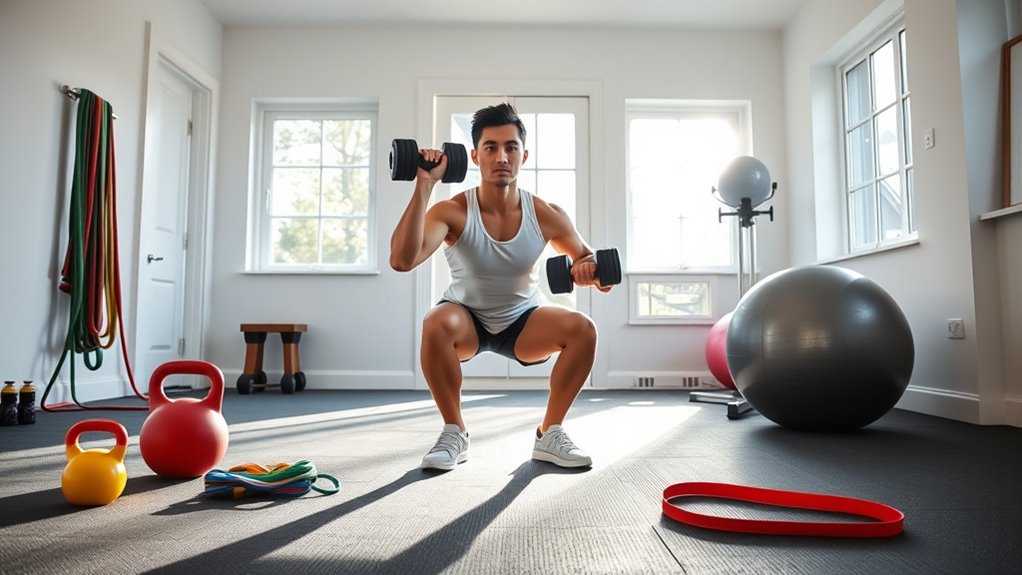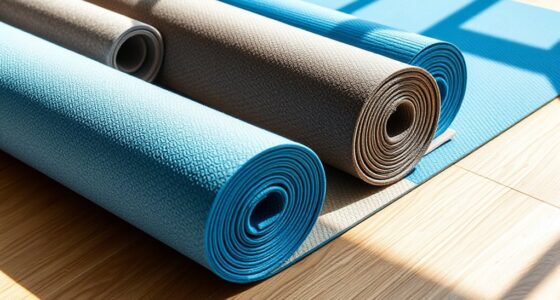A full-body routine is perfect for beginners since it targets all major muscles in each session, helping you build balanced strength and stay motivated. You’ll only need basic equipment like dumbbells or resistance bands and a clear space at home or the gym. Focus on proper form, control, and gradual progress to stay safe and see results. Keep practicing, and you’ll discover tips that make your journey even easier as you go.
Key Takeaways
- A full-body routine trains all major muscle groups in each session, promoting balanced strength and overall development.
- Use simple equipment like dumbbells and resistance bands in a well-lit, clutter-free space for convenience and safety.
- Focus on proper form, controlled movements, and correct breathing to prevent injuries and maximize effectiveness.
- Schedule workouts three times a week, gradually increasing intensity through progressive overload to build strength safely.
- Track progress, stay consistent, and incorporate motivation strategies to ensure long-term success and mental resilience.
Why a Full-Body Routine Works Well for Beginners

Starting with a full-body routine is ideal for beginners because it allows you to train all major muscle groups in each session. This approach maximizes muscle activation, helping you build balanced strength quickly. It also guarantees you don’t neglect any key areas, promoting overall development. Plus, training multiple muscles in one workout makes recovery strategies more straightforward—since you’ll typically work out three times a week, giving your muscles enough time to repair. Full-body routines help you develop consistency early on, making it easier to see progress and stay motivated. By engaging various muscles each session, you reduce the risk of overtraining specific areas and encourage better muscle coordination. Additionally, proper exercise selection ensures balanced development and minimizes injury risk. Overall, this method offers an efficient, effective way to start your strength training journey.
Essential Equipment and Space for Your Workouts

Getting started with strength training doesn’t require a lot of space or fancy equipment. You can make do with basic home gym essentials like dumbbells, resistance bands, and a comfortable mat. With smart space optimization, you’ll create an effective workout area right in your own home. Additionally, incorporating appropriate costumes and accessories can boost motivation and make your workout sessions more enjoyable.
Home Gym Essentials
Creating an effective home gym begins with choosing the right equipment and setting aside enough workout space for your routines. You don’t need a full gym—just essential exercise equipment that covers your full-body workouts. Clear, dedicated space helps you move freely and stay focused. Start with versatile items like dumbbells, resistance bands, a stability ball, and a jump rope. These tools are compact, affordable, and adaptable for various exercises. Make sure your workout space is well-lit, ventilated, and free from clutter. Having the right setup motivates you to stick with your routine and guarantees safety during exercises. Additionally, understanding fitness fundamentals can help you design effective workout plans and avoid injuries. With these home gym essentials, you’re ready to build strength and improve fitness right at home.
Space Optimization Tips
To make the most of your home gym, optimizing your space is essential for effective workouts. Start by choosing storage solutions that keep your area organized and clutter-free. Use wall-mounted racks or shelves to store small equipment like resistance bands and dumbbells. Opt for multi use equipment, such as adjustable benches or foldable cardio machines, to maximize versatility without sacrificing space. Keep your workout zone clear by regularly tidying up and designing a layout that allows free movement. Consider using compact or stackable items to save room when not in use. Proper organization and versatile equipment help you create a functional, efficient space, making it easier to stick to your full-body routine and stay motivated to train consistently. Additionally, understanding beach destinations can inspire future adventures, adding a sense of excitement and relaxation to your routine.
Sample Workout Plan for Your First Month

Creating a weekly workout schedule helps you stay consistent and track your progress. When choosing exercises, focus on a mix of compound and isolation movements to build a solid foundation. Keep your plan simple at first, gradually increasing intensity as you gain confidence and strength. Incorporating diverse plant designs into your workout space can enhance your motivation and create a more inspiring environment.
Weekly Workout Schedule
Starting a new strength training routine can feel overwhelming, but having a clear weekly workout schedule simplifies the process. It helps you stay consistent and avoid overtraining or injury. For your first month, plan workouts 3 times a week, alternating full-body sessions with rest or active recovery days. This balance allows your muscles to recover and grow. Focus on proper nutrition tips to fuel your workouts and support recovery. Incorporate injury prevention strategies, like proper warm-ups and cool-downs, into your schedule. Here’s what to keep in mind:
- Stick to a regular schedule to build habits
- Include rest days for recovery
- Prioritize proper warm-up and cool-down routines
- Follow nutrition tips to optimize results and prevent injury
- Incorporate progressive overload to steadily challenge your muscles and promote growth
Exercise Selection Tips
Choosing the right exercises is vital for building a solid foundation in strength training. Incorporate exercise variation to target muscles from different angles and prevent boredom, keeping your routine engaging. Focus on compound movements like squats, deadlifts, and presses, which work multiple muscle groups efficiently. Remember, selecting appropriate exercises also plays a key role in injury prevention; avoid overly complex or advanced movements until you’re confident in your form. Gradually increase intensity and complexity as you progress. Balance is paramount—include a mix of pushing and pulling movements to promote muscular balance and reduce injury risk. By thoughtfully choosing exercises, you’ll set yourself up for consistent progress while safeguarding your body against unnecessary strain. Additionally, understanding the importance of medication management for dementia can help ensure your routine is safe and effective, especially if you are caring for individuals with cognitive challenges.
Proper Technique and Form Tips

To maximize the benefits of strength training and prevent injuries, it’s essential to focus on proper technique and form. Avoid common mistakes like using excessive weight or rushing through reps. Pay close attention to your breathing techniques; inhale on the easier part of the movement and exhale during exertion. Keep your core engaged and maintain a neutral spine to protect your back. Make sure your movements are controlled and deliberate, not jerky. Here are some key tips:
- Maintain proper alignment and avoid overextending joints
- Focus on smooth, controlled reps rather than speed
- Use your breath to support stability and power
- Keep your shoulders back and chest up during lifts
- Understanding fundamentals of SQA can help you develop disciplined training routines that prioritize safety and effectiveness.
Progression and How to Increase Intensity

Once you’ve mastered proper technique and form, gradually increasing the intensity of your workouts helps you continue making progress. This is where progressive overload plays a key role—by steadily challenging your muscles, you stimulate growth and strength gains. You can achieve this through intensity scaling, such as adding more weight, increasing repetitions, or shortening rest periods. It’s important to make small, consistent adjustments rather than large jumps, so your body adapts smoothly without risking injury. Tracking your workouts helps you identify when to push further and ensures you’re progressing safely. Additionally, understanding the importance of proper air quality can help you maintain a healthy environment that supports your fitness goals. Remember, patience is essential; consistent, incremental increases in intensity will lead to steady improvements over time. Stick to this approach, and you’ll keep advancing toward your fitness goals.
Staying Motivated and Consistent

Staying motivated and consistent can be challenging, but your progress depends on maintaining regular workouts and a positive mindset. Developing mental toughness helps you push through tough days, while clear goal setting keeps you focused. Celebrate small victories to build confidence and stay inspired. Remember, consistency beats intensity—show up even when motivation dips. To stay on track, try these strategies:
Consistency and a positive mindset are key to staying motivated and reaching your fitness goals.
- Set specific, achievable goals to measure your progress
- Track your workouts to see improvements over time
- Find a workout buddy for accountability
- Remind yourself of your reasons for starting
Positive Thinking techniques can significantly boost your resilience and outlook throughout your fitness journey.
Frequently Asked Questions
How Often Should I Rest Between Workouts?
You should take rest days every 48 to 72 hours between workouts to allow your muscles to recover properly. Incorporate recovery strategies like stretching, hydration, and adequate sleep to enhance your progress. Listen to your body; if you feel excessive soreness or fatigue, add an extra rest day. Rest is essential for preventing injuries and ensuring you gain strength effectively from your full-body routine.
Can I Do Full-Body Workouts at Home Without Equipment?
Yes, you can definitely do full-body workouts at home without equipment using bodyweight exercises. Incorporate moves like push-ups, squats, lunges, and planks into your home workout routines. These exercises target multiple muscle groups and are effective for building strength. You just need space and consistency. Aim to do these routines 2-3 times a week, and gradually increase reps or sets for continued progress.
How Do I Prevent Injuries During Strength Training?
You can prevent injuries during strength training by always doing a proper warm-up to prepare your muscles and joints for activity. Focus on maintaining correct form during each exercise to avoid strain or tears. Avoid rushing through reps, listen to your body, and don’t push past discomfort. Consistent warm-ups and proper form keep you safe, help you progress, and guarantee you get the most out of your workouts.
What Are Signs of Overtraining or Burnout?
You’ll notice signs of overtraining or burnout when you experience persistent muscle fatigue and mental exhaustion. If your workouts feel unusually hard, you’re constantly sore, or you lack motivation, it’s a warning sign. You might also notice decreased performance, trouble sleeping, or increased irritability. Pay attention to these signals, rest appropriately, and give your body time to recover to prevent injury and keep progressing safely.
Should Beginners Focus on Cardio or Strength First?
You should prioritize strength focus initially to build a solid foundation and improve overall muscle mass. Cardio prioritization can come later to boost endurance, but balancing both is key. As a beginner, focus on strength first to develop proper form and prevent injuries. Once you’re comfortable, gradually incorporate cardio workouts to enhance cardiovascular health. Always listen to your body, and don’t neglect rest to avoid overtraining or burnout.
Conclusion
Remember, this journey is yours to shape, like carving a sculpture from stone. Stay consistent, embrace the small victories, and each workout will add a new brushstroke to your masterpiece. Think of strength training as planting seeds—patience and effort will turn them into a flourishing garden. Keep moving forward, and soon you’ll see your confidence and strength grow tall and strong, transforming your body into a work of art you’re proud of.









